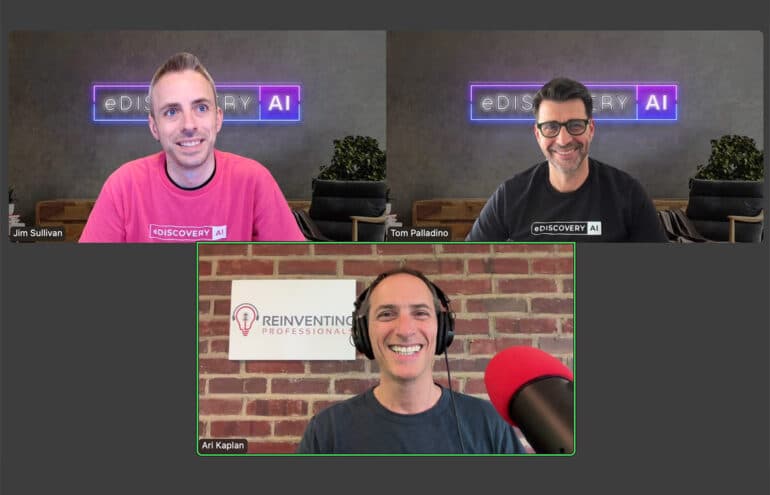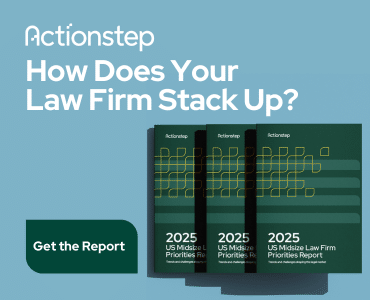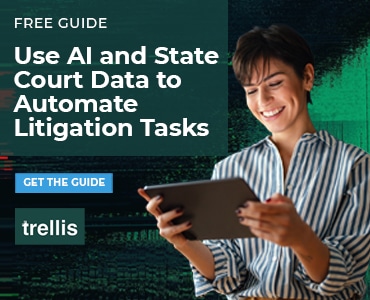Ari Kaplan of Ari Kaplan Advisors speaks with Jim Sullivan and Tom Palladino, founder and president, respectively, of eDiscovery AI, which leverages artificial intelligence for document review, privacy response, investigations and litigation.

Ari Kaplan, Ari Kaplan Advisors: Tell us about your background and the genesis of eDiscovery AI.
Jim Sullivan, Founder, eDiscovery AI: I’m an attorney with about 10 years of experience in the discovery space. I was a traditional predictive coding nerd, consulting on using technology to solve eDiscovery problems. This came from my experience using analytics and predictive coding on eDiscovery cases, where I saw the shortcomings and problems that we struggled to solve 10 years ago. I saw how well AI could solve problems that previously had no solution. A lot of what we’re doing involves building solutions to long-standing problems that we can now address, while also exploring new directions that leverage generative AI to enhance the entire process.
AK: Tell us how your experience in the legal industry has helped shape the vision for applying AI to discovery.
Tom Palladino, President, eDiscovery AI: I was one of the co-founders, alongside Andrea Wallack, of NightOwl Global, which HaystackID acquired in 2020. I remained with Haystack for two years and then spent another year outside the industry. I continued attending Legalweek to see friends and was introduced to Jim. I was completely impressed by what he had already built and wanted to be part of it right away. In the year and a half I’ve been working with Jim, I see increasing potential for this in the future.
AK: What should legal professionals be doing today to prepare for and adapt to an AI-centric eDiscovery landscape?
Jim Sullivan: Just use it. Use it for fun, use it for work. Generative AI is incredibly powerful. Most people have access to simple tools like ChatGPT to help brainstorm ideas and answer questions. You gain experience by using it, observing how it works, how it responds, what it excels at, and what it struggles with. Then, take that further and incorporate it into your job.
A common mistake I’ve seen, especially with predictive coding, is people who are forced to use the technology out of necessity or panic, without enough time to learn it. They end up using it for the first time on the biggest projects in their lives.
Avoid that. Test it with small projects and small tasks first. Next, run generative AI alongside your current process to compare results, so when it’s time to tackle those major projects, you’ll already understand how it works and be familiar with its capabilities.
AK: What is early case intelligence, and how does it affect the way legal teams prepare for complex litigation?
Tom Palladino: I was an early tech adopter throughout my career and really liked the early case assessment (ECA) tools available because they helped people analyze data sets and understand them more quickly. When I started to grasp the capabilities of generative AI, I immediately thought of that initial phase of the process. However, I didn’t believe ECA fully captured the current methodology because, although those tools can generate concepts and cluster data, they can’t provide meaningful insights at the beginning. The technology is advancing rapidly, and the perspectives we can gain in a case, investigation, litigation, or breach are incredible. For this reason, I believe early case intelligence is more appropriate.
The amount of information that can be derived from small and large data sets within days, compared to the 12 weeks it took to do so in 2022 or 2023, will transform our industry.
Gaining data insights earlier in litigation will change the relationships among corporations, law firms, outside providers and software developers.
AK: How does identifying key documents, people, and events before a document review begins empower litigation support teams?
Jim Sullivan: It gives you greater knowledge and insights into your data, making the overall process more efficient. We are always looking for ways to deliver helpful information as early as possible with minimal effort. Our goal is to prevent litigation teams from doing unnecessary upfront work. Even when using predictive coding, legal professionals prefer efficient methods to train their models. We focus on providing teams with information quickly, making sure the data they need is easily accessible.
AK: Where do you see the most significant opportunities for legal teams to improve outcomes in e-discovery and litigation by embracing AI?
Tom Palladino: We are in a risk assessment industry. Most decisions about spending and proportionality are based on this, and AI will accelerate the risk assessment process. AI will help teams reach conclusions about cases more quickly before making major investments, which benefits everyone. The increasing volume of data that needs management can only be effectively handled with AI-enabled tools today because traditional methods are no longer sufficient. Criminal defendants face particular challenges when sorting through vast amounts of data. Generative AI will aid in managing and speeding up this process, acting as a field leveler. As a result, I don’t believe large productions and lengthy case cycles will necessarily continue to be an advantage. There will be shifts in litigation driven by changes in the risk assessment cycle.
AK: How do you see e-discovery evolving?
Jim Sullivan: We will be able to identify risks earlier, allowing us to act before issues lead to litigation or, at the very least, reduce them to help companies save money related to those risks. Early risk detection offers many benefits, including saving time and money. Minimizing the discovery or review phase makes it easier, faster, and cheaper to access necessary information. This enables us to concentrate on other critical aspects of the case and quickly assess whether we are likely to win or lose, helping us decide if a settlement is appropriate. Much of the case strategy relies on the knowledge and information we can gather and continuously improve, aiming for instant access to everything we need.
Ari Kaplan regularly interviews leaders in the legal industry and the broader professional services community to share perspectives, highlight transformative change, and introduce new technology at ReinventingProfessionals.com.
Listen to his conversation with eDiscovery AI’s Jim Sullivan and Tom Palladino here.
Read more of Ari’s interviews on Attorney at Work here.
Image © iStockPhoto.com.

Sign up for Attorney at Work’s daily practice tips newsletter here and subscribe to our podcast, Attorney at Work Today.
Illustration ©iStockPhoto.com
Subscribe to Attorney at Work
Get really good ideas every day for your law practice: Subscribe to the Daily Dispatch (it’s free). Follow us on Twitter @attnyatwork.
















